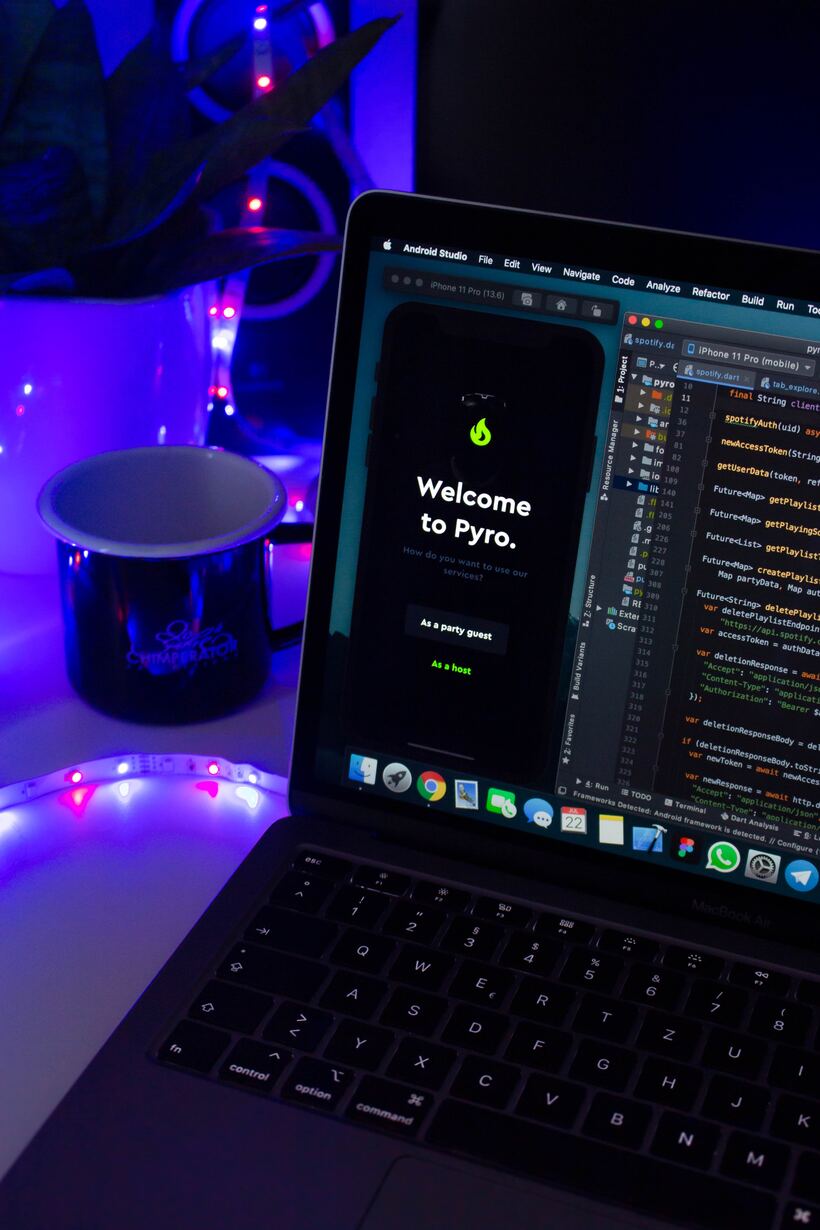Welcome to the world of web development, where the magic happens behind every click and tap on your favorite websites and online applications! Have you ever wondered about the difference between frontend and backend development? Do you know where React.JS fits into this intricate digital puzzle? Join us on a journey through the realms of frontend and backend technologies as we unravel the mysteries of React.JS - a powerful tool that blurs the lines between front-end and back-end functionalities. JavaScript developers create React.JS, and let's dive in and explore the fascinating world of React.JS developers!















What is the Difference Between Frontend and Backend Development?
Frontend technology user interfaces and backend development are like the yin and yang of web applications, each playing a crucial role in delivering a seamless user experience. Frontend development focuses on what users see and interact with - the layout, design, and interactivity of a website or application. It involves coding languages like HTML, CSS, and JavaScript integration to create visually appealing interfaces that engage users. On the other hand, backend development deals with the behind-the-scenes magic that powers the frontend, JavaScript library used. Backend developers work on server-side technologies, database schemas, and APIs to ensure data is processed efficiently and securely. They make sure everything runs smoothly behind the curtains while users enjoy a smooth experience on the frontend. Together, frontend and backend developers collaborate to bring life to digital products by harmonizing design with functionality, developer implements the design for an unparalleled user experience.Understanding Frontend Development
Frontend development is like the facade of a building - it's what users interact with. It involves creating the visual elements and user optimized interface components that people see and engage with on websites or applications. Frontend developers need to have an eye for design and a knack for translating ideas into code, frontend is working perfectly fine. These developers work closely with designers to bring mockups and wireframes to life, ensures that the frontend final product not only looks good but also functions seamlessly. They use languages like HTML, CSS, and JavaScript to build responsive layouts, implement animations, and handle user interactions. Understanding frontend development efficiency requires staying up-to-date with the latest trends in web design elements and technology, languages used in frontend development. It's a dynamic field that constantly evolves as new tools and react js framework emerge to enhance user experiences.
Understanding Backend Development
Backend development involves working on the server-side of applications, focusing on databases, servers, and application logic. It's like the engine of a car that powers everything behind the scenes.In backend development, programmers use languages like Python, Ruby, Java, languages used in backend development, to create algorithms and data structures that support the functionalities of an application. Developers in this domain work on optimizing performance, securing data storage with encryption techniques, and ensuring seamless communication between various component hierarchy in a React. They also deal with API integrations for connecting different software systems together efficiently. API capabilities refer to the functionalities and features that an Application Programming Interface (API) provides for communication between different software systems. Understanding backend development requires a deep understanding of how servers operate and how to manage large amounts of data effectively. Back-end developers play a crucial role in building robust and scalable web applications, backend is how everything works, that can handle heavy traffic loads without compromising high-speed capabilities or security.What are the Common Technologies Used in Backend Development?
Backend development involves working with a variety of technologies to ensure server-side functionalities run smoothly. Commonly used technologies in backend development include programming languages like Python, Ruby, Java, and PHP. These languages provide the foundation for building robust backend systems. Databases play a crucial role in storing and managing data on the backend. Technologies such as MySQL, PostgreSQL, MongoDB, and Redis are frequently utilized for efficient data storage and retrieval. To streamline backend development, hire one developer, a JS framework like Node.js, Django, Flask, Spring Boot helps by providing ready-to-use components and structures. Back4App is a backend-as-a-service (BaaS) platform that provides scalable and flexible solutions for building serverless applications.It simplifies the process of developing and managing the backend infrastructure, called frontend, allowing developers to focus on building frontend applications. Back4App supports various frontend frameworks, including React.js. APIs (Application Programming Interfaces) enable communication between different software applications on the backend. RESTful APIs or GraphQL are commonly implemented to facilitate smooth interaction between various services within a system. Here are some key factors that contribute to API reliability:- Uptime and Availability: An essential aspect of API reliability is the uptime and availability of the service. Users expect the API to be accessible whenever they need it. Service Level Agreements (SLAs) often define the acceptable level of uptime, usually expressed as a percentage of time.
- Consistency and Predictability: A reliable API should provide consistent and predictable responses. Users rely on the API behaving in a certain way, and any unexpected changes can disrupt their applications. Well-documented and stable APIs are crucial for maintaining reliability.
- Error Handling: A robust API should have clear and informative error messages. Proper error handling helps developers understand what went wrong, why it happened, and how to resolve the issue. Consistent error codes and messages make troubleshooting easier.
- Rate Limiting: Implementing rate limiting mechanisms prevents abuse and ensures fair usage of the API. By limiting the number of requests a client can make within a specific timeframe, the API can avoid being overwhelmed and maintain responsiveness.
- Scalability: As usage of an application grows, the API should be able to scale to handle increased traffic and demand. Scalability is crucial to ensure that the API can perform well under various loads.

What are the Key Skills Required for Frontend Development?
Frontend development requires a unique set of skills that focus on creating engaging user experiences, frontend development whereas what happens. First and foremost, proficiency in HTML, CSS, and JavaScript is essential. Being able to structure content with HTML syntax, style it with CSS, and add interactivity using JavaScript are foundational skills for any frontend developer. Understanding responsive design principles is crucial in today's mobile-centric world. Frontend developers need to ensure that websites look great and function seamlessly across various devices and screen sizes. Proficiency in CSS frameworks like Bootstrap or Materialize can aid in achieving this goal efficiently. Knowledge of version control systems like Git is vital for collaborating with other team members effectively. Additionally, having an eye for design aesthetics and the ability to work closely with UI/UX designers can elevate the overall look and feel of a website or application components. Staying up-to-date with emerging technologies and trends in the frontend development landscape is key to remaining competitive in this fast-paced industry, whether React version js or Vue.js. Learning new tools like React JS or Vue.js, tools used to develop React, can open doors to exciting opportunities in frontend development projects.What are the Key Skills Required for Backend Development?
Backend development requires a diverse skill set to build the server-side of web applications. Proficiency in programming languages like Python web framework, Java, or Ruby is crucial for backend developers to create robust back-end logic. Understanding databases and query languages such as SQL or NoSQL is essential for managing data efficiently, pros and cons of React. Knowledge of server-side frameworks like Node.js, Django, or Flask enables backend developers to streamline application development. Familiarity with APIs and RESTful services helps in integrating front-end components with the back end seamlessly, tons of React background comes under backend development. Keep your React problem-solving skills are vital for debugging and optimizing code for enhanced performance. Node.js vs Next.js is a common topic in this context. While Node.js is a fundamental runtime environment for JavaScript, Next.js is a React framework that leverages Node.js for its backend capabilities. Next.js focuses on server-side rendering and offers features like API routes, static site generation, and pre-rendering for improved performance and SEO. Understanding the distinction between these two technologies helps backend developers choose the right tools for their specific needs and project requirements. Version control systems like Git play a significant role in collaboration and code management within development teams. Staying updated on emerging technologies and trends in backend development ensures continuous growth as a proficient backend developer.
Is React JS Used for Frontend, Backend, or Both?
When diving into the world of web development, one question that often arises is: Is React JS used for frontend or backend framework? Well, let's uncover this intriguing aspect of React JS. React JS primarily shines in the realm of frontend development and is used in both frontend and backend development through frameworks like Next.js or Gatsby.js. Its declarative and component-based structure makes it a top choice for crafting dynamic user interfaces with ease and efficiency. With its virtual DOM(Document Object Model) concept, React ensures fast server rendering and seamless updates to keep users engaged. React JS can also be utilized in both frontend vs backend development through frameworks like Next.js or Gatsby.js, whether React JS is frontend or backend, for server-side rendering capabilities or static websites generation using React components. These scalable frameworks, used front-end JS development framework, enhance the capabilities of React in a variety of use cases. So, whether you're building captivating frontends or robust backends, React JS proves to be a versatile tool that adds value to your web development projects, main objectives of the frontend developer.Exploring the Role of React JS in Frontend Development
When it comes to frontend development, React JS plays a crucial role in creating interactive user interfaces, developers to investigate the React. With its component-based architecture, React allows developers to build reusable UI elements efficiently. React's virtual DOM enables quick rendering of changes, resulting in smoother user experiences on web applications, used in web development. Its declarative approach simplifies the process of updating and manipulating the UI based on data changes. By using JSX, a syntax extension that combines HTML with JavaScript, developers can write components more intuitively. This helps in enhancing code readability and maintainability. React's one-way data flow ensures predictable state management within components, making it easier to debug any react projects and maintain large-scale applications. React JS empowers frontend developers to create dynamic and responsive web interfaces with ease and scalability.
Exploring the Role of React JS in Backend Development
React JS, primarily known for frontend development, has also gained traction in the backend realm. Its versatility allows developers to build powerful server-side applications with ease. In backend development, React JS can be utilized to create interactive user interfaces and manage data flow efficiently. It offers a component-based architecture that simplifies the process of building complex backend systems. By leveraging React JS in backend development, developers can take advantage of reusable components and a virtual DOM for seamless performance optimization, makes the development much faster. This enables faster rendering and updates without compromising on functionality. Using a Virtual Private Servers (VPS) with React.js is a common and effective way to deploy and host React.js applications. A VPS provides a dedicated virtualized server environment that allows you to have more control over the configuration, resources, and deployment of your React.js application compared to shared hosting solutions. With React JS used for the development on the backend, developers can enhance user experience by creating dynamic content that responds swiftly to user interactions. This results in more responsive web applications with improved scalability and maintainability.Understanding the Versatility of React JS for Both Frontend and Backend
React JS is a versatile framework that can be utilized for both frontend and backend development. Its flexibility allows developers to create interactive user interfaces on the frontend while also handling server-side logic on the backend. This duality makes React JS a powerful tool in building full-stack applications seamlessly. On the frontend, React JS enables developers to design dynamic and responsive user compact interface with ease. Its component-based architecture promotes code reusability and maintainability, enhancing overall productivity. Developers can leverage its virtual DOM to efficiently update UI components without reloading the entire page. When it comes to backend development, React JS can be integrated with Node.js to build robust server-side applications. In the context of Node.js, which uses a non-blocking I/O model, the key idea is to leverage an event-driven, asynchronous architecture. By using frameworks like Express.js, developers can create APIs and handle database operations effectively within the same ecosystem as their frontend codebase. Virtual reality integration (VR) into a React.js application involves using libraries like react and frameworks that enable the creation and rendering of VR content within a web environment. React JS's ability to cater to both frontend and backend requirements makes it a valuable asset for developers seeking a comprehensive solution for their web application projects.
Comparing React JS with Other Frontend and Backend Frameworks
When it comes to comparing React JS with other frontend and backend frameworks, several aspects come into play. React JS stands out for its component-based architecture, making it highly modular and efficient for building user interfaces. Unlike traditional MVC frameworks, React's virtual DOM ensures faster rendering and updates without compromising performance. In contrast, Angular offers a more opinionated structure with two-way data binding, while Vue.js provides simplicity and flexibility in its approach. On the backend side, Node.js is often paired with React for full-stack development due to their shared JavaScript engine. Frameworks like Django, Digital Ocean or Ruby on Rails offer robust backend solutions but may require additional setup when integrated with React. Each framework has its strengths and weaknesses, catering to different project requirements and developer preferences. The choice between frameworks boils down to scalability needs, community support, learning curve, and project goals.Understanding the Role of React Native in App Development
React Native, a popular framework developed by Facebook, allows developers to build mobile applications for both iOS and Android platforms using JavaScript. With React Native, developers can develop a cross-platform, then React development that offers a native-like experience to users without compromising performance. One of the key advantages of React Native is its ability to streamline the software development process by allowing code reusability across different platforms. This not only saves time but also reduces the effort required to maintain multiple codebases for each platform. React Native can develop for Android has become a go-to choice for many app developers looking to create high-quality, efficient mobile applications that can reach a wide audience on both iOS and Android devices.
What are The Specific Technical Skills Needed for a React JS Developer?
When it comes to being a React JS developer, there are specific technical skills that can set you apart in the field. Having a strong foundation in JavaScript is crucial as React is built on this language. Understanding concepts like ES6 syntax, closures, and asynchronous programming will be beneficial. Proficiency in HTML and CSS is essential for crafting well-designed user interfaces. Being able to manipulate the DOM efficiently and style elements effectively is key to creating visually appealing websites or applications. Knowledge of state management libraries like Redux capabilities or MobX can enhance your ability to manage data flow within your React applications. Familiarity with routing using tools like React Router is also valuable for building dynamic web pages. Mastering these technical skills in both frontend will empower you to leverage the power of React JS effectively in developing robust and functional web applications.Key Front-end Technical Skills for React JS Developers
When it comes to React JS development, front-end technical skills play a vital role in creating dynamic user interfaces. A React JS developer should be proficient in HTML, CSS, and JavaScript to effectively design and style web applications. Understanding the virtual DOM concept is crucial for optimizing performance and web page rendering updates efficiently. Proficiency in utilizing state management tools like Redux or Context API is essential for managing application state seamlessly. Knowledge of asynchronous programming with promises or async/await ensures smooth data fetching from APIs. Familiarity with responsive design principles using media queries and flexbox enhances the user experience across various devices. Experience with debugging tools such as Chrome DevTools helps in identifying and fixing issues quickly. Continuous learning and staying updated with the latest trends in front-end technologies are key to becoming a successful React JS developer.
Key Back-end Technical Skills for React JS Developers
When it comes to backend development with React JS, there are some key technical skills that developers should possess. Understanding server-side programming languages like Node.js is crucial for building scalable applications. Proficiency in databases such as MongoDB or MySQL is essential for storing and retrieving data efficiently. Knowledge of RESTful APIs and GraphQL for creating communication interfaces between the frontend and backend is vital. Being familiar with authentication methods like JWT tokens ensures secure access to resources. Expertise in state management tools like Redux helps in managing application state effectively. Understanding cloud services such as AWS or Microsoft Azure can optimize deployment processes. Experience with testing frameworks like Jest ensures the server reliability and quality of code implementations. Continuous integration/continuous deployment (CI/CD) practices are necessary for efficient development workflows. Mastering these back-end technical skills equips React JS developers to build robust and dynamic web applications seamlessly integrated with the frontend functionalities.Understanding The Usage of JavaScript in React Application Development
JavaScript plays a crucial role in React application development as it is the programming language that powers React. JavaScript allows developers to create interactive user interfaces by manipulating the DOM elements efficiently. In React, JavaScript, written in JavaScript, is used to define components, manage state, and handle events seamlessly. By utilizing JavaScript in React development, developers can build dynamic web applications that offer a smooth user experience. JavaScript's flexibility and versatility enable developers to update content on the page without needing to refresh it entirely. JavaScript enables data binding in React components, making it easier for developers to real-time synchronization changes between different parts of the application. Data synchronization in React.js typically involves keeping the state of your application components in sync with the underlying data. This can include data fetching, updating, and managing the flow of data between different components. With its rich ecosystem of libraries and packages, JavaScript complements React's functionality by providing additional tools for building robust applications. When working with React.js, there are numerous npm packages available to enhance development, provide additional functionalities, and streamline common tasks. Understanding how JavaScript integrates with React is essential for maximizing the multitasking capabilities of this popular frontend framework.
Exploring the Backend Technologies Compatible with React JS
When it comes to exploring backend technologies that are compatible with React JS, developers have a wide array of options at their disposal. One popular choice is Node.js, a powerful JavaScript runtime environment to be used to server-side scripts. This seamless integration between React and Node.js enables developers to build full-stack applications efficiently. Another noteworthy backend technology that complements React JS is Express.js. As a minimalistic and flexible Node.js web application framework, Express simplifies the process of building robust APIs and handling HTTP requests in conjunction with React components. For database management in React-based projects, MongoDB stands out as a top choice due to its scalability and flexibility. By leveraging the MERN (MongoDB, Express, React, Node) stack, developers can create dynamic web applications seamlessly integrating frontend components with backend functionalities. Understanding how different backend technologies complement React JS empowers developers to create innovative solutions across various projects effortlessly.Utilizing Developer Tools in React Application Development
Developing React applications efficiently requires leveraging various developer tools to enhance the coding process and debug effectively. Tools like React DevTools enable developers to inspect component hierarchies, monitor component states, and track updates in real-time data tools. Visual Studio(VS Code) is a popular integrated development environment (IDE) developed by Microsoft and supports a wide range of programming languages and frameworks, including a wide range of React.js. Tools such as Redux DevTools assist in managing application state changes and debugging Redux workflows seamlessly. Integrating ESLint for code linting ensures adherence to best practices and maintains code quality throughout the development cycle. Utilizing Chrome Developer Tools for performance profiling helps optimize application development speed by identifying bottlenecks and improving overall user experience. Developer tools are essential tools, and by harnessing these tools effectively, React developers can streamline their workflow performance, identify issues swiftly, and deliver high-quality applications efficiently.
How does a React JS Developer Contribute to Frontend and Backend Development?
As a React JS developer, you play a crucial role in bridging the gap between frontend and backend development. Your expertise allows you to create dynamic user interfaces that seamlessly interact with the server-side logic. By utilizing React components, you can efficiently manage the presentation layer of an application while ensuring smooth data flow between the front and back ends. In frontend development, your skills help in crafting visually appealing and responsive web pages that enhance user experience. You leverage React's virtual DOM to optimize rendering performance and provide a seamless browsing experience for users. On the backend side, your knowledge enables you to integrate APIs, handle data manipulation tasks, and ensure proper communication between different parts of the application. Your contribution as a React JS developer empowers teams to build scalable and robust applications that meet modern technological demands. Whether working on client-facing features or server-side development, your ability to navigate both worlds makes you an invaluable asset in creating cutting-edge web solutions.Understanding the Role of React in Building User Interfaces
React plays a crucial role in building user interfaces by allowing developers to create interactive and dynamic web applications. Its component-based architecture makes it easy to create reusable UI elements, streamlining the development process. With React, developers can efficiently manage the state of components, ensuring a seamless user experience. One key aspect of React is its virtual DOM, which helps optimize performance by only re-rendering components that have changed. This results in faster loading times and smoother interactions for users. Additionally, React's JSX syntax enables developers to write HTML-like code within JavaScript, making it easier to visualize and manipulate the UI structure. By utilizing React's declarative approach to programming, developers can describe how the UI should look based on data changes without worrying about manual updates. This simplifies the process of building complex user interfaces and enhances productivity during development tasks.
Exploring the Significance of React JS in Frontend Web Application Development
When it comes to frontend web application development, React JS stands out as a powerful tool in the developer's arsenal. Its component-based architecture allows for easy creation and maintenance of interactive user interfaces. With virtual DOM rendering, React ensures optimal performance by updating only the necessary components when data changes. React's declarative nature simplifies the process of building complex UIs, making it easier for developers to manage state and handle events efficiently. By utilizing reusable components, developers can enhance code reusability and maintainability across projects. React's ecosystem offers a wide range of libraries and tools that streamline development processes and enable seamless integration with other technologies. This flexibility empowers developers to create dynamic and responsive web applications that meet modern user expectations seamlessly.Integration of React JS in a Wide Range of Frontend and Back-end Development Projects
React JS is a versatile tool that seamlessly integrates into a wide array of frontend and backend development projects. Whether you're working on building a dynamic user interface or optimizing server-side functionalities, React JS proves to be an invaluable asset. In frontend development, React JS allows for the creation of interactive components that enhance user experience and engagement. On the backend side, React JS can be utilized to streamline data management processes and improve overall system performance. The ability of React JS to work harmoniously across both frontend and backend environments, works with React, makes it a popular choice among developers looking for efficiency and flexibility in their projects. By leveraging its capabilities effectively, developers can create robust applications that meet modern technological demands. From e-commerce platforms to social networked applications, integrating React JS enables developers to deliver cutting-edge solutions tailored to specific project requirements. Its adaptability ensures seamless connectivity between different parts of the application architecture, resulting in cohesive end products that drive success in today's competitive digital landscape.
Utilizing React for Both Web and Mobile App Development
When it comes to utilizing React for both web and mobile app development, developers have a powerful tool at their disposal, basic concepts of React. React's versatility allows for seamless transitions between building user interfaces for web applications and crafting engaging experiences in Native mobile apps. With React's component-based architecture, developers can efficiently reuse code across different platforms, ensuring consistency and saving valuable time during the development process. This flexibility enables teams to create responsive designs that adapt seamlessly to various screen sizes and devices. By leveraging React Native, a framework built on top of React, developers can extend their skills from web development to mobile app creation with ease. This cross-platform compatibility streamlines the workflow and empowers developers to reach a broader audience by releasing applications on multiple platforms simultaneously. Firebase is a comprehensive mobile and web application development platform provided by Google. It offers a variety of services, including real-time databases, user authentication, hosting services, cloud functions, and more. When using Firebase with React.js, developers can leverage its features to build powerful and scalable applications. Hybrid mobile apps allow you to use web technologies, such as HTML, CSS, and JavaScript, to build mobile applications that can run on both iOS and Android platforms. React Native is a popular framework for building hybrid mobile apps with React.js. The ability to utilize React for both web and Mobile App Development with React.JS showcases its strength as a versatile framework that caters to diverse project requirements.Whether you're working on a website or developing an innovative mobile application, React provides the tools needed to bring your ideas to life effectively.Comparing React with Other JavaScript Libraries and Frameworks
When it comes to comparing React with other JavaScript libraries and frameworks, there are key distinctions that set React apart. React's component-based architecture allows for the creation of reusable UI components, providing a more organized and efficient development process. This modularity makes maintenance and updates easier compared to monolithic frameworks. In contrast to Angular, which follows an MVC architecture, React focuses on the view layer only. This simplicity leads to faster rendering times and improved performance. Vue.js, another popular framework, shares similarities with React in its component-based approach but differs in its learning curve and ecosystem size. React's virtual DOM implementation enhances efficiency by minimizing actual DOM manipulations. This results in smoother user experiences and better overall performance compared to traditional DOM manipulation methods used by jQuery or vanilla JavaScript. Despite these differences, each frontend library or framework has its strengths depending on project requirements and developer preferences. It is essential to assess individual needs carefully before choosing the right tool for a web development project.
What are the Advantages of Using React JS for Frontend and Backend Development?
When it comes to React JS, the advantages for both frontend and backend development are plentiful. React's component-based architecture allows for reusability and easy maintenance of code. This means developers can efficiently update and scale applications without starting from scratch. Heroku is a cloud platform that enables developers to deploy, manage, and scale applications easily. It supports various programming languages and frameworks, including Node.js, which is commonly used for building React.js applications. Offline data support in a React.js application involves implementing strategies for data storage, synchronization, and handling scenarios where the user is not connected to the internet. React's virtual DOM enables faster rendering by only updating the necessary components when data changes. This results in improved performance and a smoother user experience. Additionally, React's one-way data binding ensures predictable data flow throughout the application, reducing bugs and making debugging easier. WebSockets provide a full-duplex communication channel over a single, long-lived connection, allowing real-time data transfer between a client (such as a React.js application) and a server. React.js can utilize WebSockets to enable real-time features like live updates, chat applications, and collaborative editing. Rapid prototyping in React.js involves quickly creating a basic version of your application to test-driven development, gather feedback, and validate concepts before investing significant time in development. React's component-based architecture makes it well-suited for rapid prototyping. ASP.NET Core is a cross-platform, high-performance, and open-source framework for building modern, cloud-based platform, and internet-connected applications. It is developed by Microsoft and is well-suited for building web applications, including those that use React.js for the front end. With React Native, developers can use their existing skills to build mobile applications for both iOS and Android platforms. This cross-platform compatibility saves time and resources while ensuring a consistent user experience across devices. Here are some strategies for app scaling:- Optimize Frontend Performance: Use code splitting to break down your application into smaller chunks. This helps in loading only the necessary code for the initial view and loading additional parts as needed. Employ lazy loading for components and assets that are not immediately required.
- Backend Scaling Strategies: Use load balancing to distribute incoming traffic across multiple servers. This ensures even distribution of the load and prevents any single server from becoming a bottleneck.Consider horizontal scaling by adding more server instances. This can be achieved by deploying your application on multiple servers or using containerization and orchestration tools like Docker containers and Kubernetes.
- Content Delivery Network (CDN): Utilize a Content Delivery Network (CDN) to serve static assets such as images, stylesheets, and scripts. CDNs cache content on servers distributed globally, reducing latency for users.
- Serverless Architecture: Serverless Functions: Consider using serverless functions for specific tasks or features. Serverless architectures can automatically scale based on demand, and services like AWS Lambda or Azure Functions can be integrated.
Understanding the Open-source Nature of React JS and JavaScript
React is an open-source technology, and JavaScript are both open-source, meaning they are freely available for developers to use, modify, and distribute. This open nature fosters a collaborative community where developers can contribute to the improvement of these technologies, react is JavaScript, through feedback and code enhancements. The transparency of open-source projects like React JS allows for continuous updates and improvements based on real-world usage and feedback from the developer community, community which makes the development. By being open source, React JS encourages innovation as developers have access to the source code, enabling them to customize and extend its functionalities according to their specific project requirements. Furthermore, the open nature of React JS promotes accessibility and inclusivity by allowing developers from diverse backgrounds to leverage its capabilities without any licensing restrictions. JavaScript's status as an open-source javascript further enhances its versatility in web development by providing a foundation that supports various frameworks like React JS. As a result, developers can harness the power of JavaScript alongside React JS, js is an open-source library, to build dynamic web applications efficiently while benefiting from ongoing community-driven support and enhancement initiatives.
Exploring the Unique Features of React JS for Building Robust Applications
Exploring the unique features of React JS unveils a world of possibilities for building robust applications. One standout feature is virtual DOM, which enhances performance by updating only the necessary components without reloading the entire webpage. This efficiency makes React ideal for dynamic and interactive user interfaces. Another key feature is JSX, a syntax extension that allows developers to write HTML directly within JavaScript code. This seamless integration simplifies component creation and boosts productivity during development. Additionally, React's one-way data flow ensures predictable behavior and easy debugging in complex applications. React's reusable components enable developers to create modular architecture and scalable code structures, promoting code reusability and maintainability across projects. Furthermore, its extensive ecosystem with libraries like Redux provides state management solutions for handling application data efficiently. Here's how you can find reviews for React.js on GitHub:- Repositories with Stars and Forks: Look for popular React.js repositories on GitHub by searching for terms like "react" or "reactjs" in the GitHub search bar. Repositories with a higher number of stars and forks generally indicate popularity and may have useful reviews and discussions.
- Readme and Documentation: Once you find a repository, review its README file and documentation. Authors often include information storage about usage, features, and community support. Users may also provide feedback or raise issues in the repository's "Issues" section.
- Issues and Pull Requests: Browse through the repository's "Issues" tab to see if users have reported bugs, requested features, or provided feedback. Additionally, check the "Pull Requests" tab to see proposed changes and discussions related to the project's development.
- Community Forums and Discussions: Some repositories may have associated community forums, Discord servers, or other communication channels where users discuss the project, ask questions, and share feedback. Check the repository's README or website for links to these resources.
- Third-party Reviews and Articles: Look for third-party reviews, tutorials, and articles about React.js libraries and frameworks. Blog posts, YouTube videos, and tech websites often provide in-depth reviews and comparisons based on personal experiences.
- Social media integration and Developer Platforms: Follow React.js developers and influencers on social media platforms like Twitter, LinkedIn, and Reddit. They may share insights, reviews, and recommendations for React.js projects.
Utilizing React for a Wide Range of Frontend and Backend Projects
React JS is a powerful tool that can be utilized in a wide range of frontend and backend projects, making it a versatile choice for developers. On the frontend side, React allows for the creation of dynamic user interfaces with its component-based architecture, web development to build interactive elements and engaging web applications. When it comes to backend development, React can also be used in conjunction with Node.js to create full-stack applications, offering seamless integration between the front and back ends. Securing a React.js application involves implementing various best practices to protect it from common security vulnerabilities. The ability to reuse components across both frontend and backend systems streamlines development processes and enhances efficiency for developers working on multifaceted projects. By leveraging React's flexibility and scalability, developers can ensure consistency in design elements while optimizing performance across various platforms.
Advantages of Using React for Developing Web Applications
When it comes to developing web applications, React JS offers a plethora of advantages that make it a popular choice among developers. One key advantage is its component-based architecture, allowing for the creation of reusable UI components which simplifies the development process and enhances code maintainability. React's virtual DOM efficiently updates and renders only the necessary components when data changes, leading to improved performance and a seamless user experience. This helps in creating fast-loading web applications while reducing unnecessary re-renders. React's one-way data flow ensures predictable behavior by making it easier to debug and trace errors within the application. Its rich ecosystem with tools like Redux for state management further enhances scalability and flexibility in building complex web applications. Creating a cost-effective environment for a React.js project involves making strategic decisions about hosting, development tools, and services to minimize expenses while maintaining performance and scalability. React's strong expert community support provides access to a vast array of libraries, resources, and documentation that aid developers in overcoming challenges and continuously improving their skills.How React JS Streamlines the Development of Both Frontend and Backend Functionalities
React JS is a powerful tool that streamlines the development process by allowing developers to work on both frontend and backend functionalities seamlessly. With React, developers can create interactive user interfaces efficiently, enhancing user experience. By utilizing reusable components, React simplifies code maintenance and updates across different parts of the application. The virtual DOM feature in React enables faster rendering of changes made to the UI, optimizing performance. This results in smoother interactions for users without having to reload the entire page. Additionally, React's one-way data flow ensures predictable behavior within the application, making it easier to debug and maintain code. With the ability to integrate with various backend technologies like Node.js or Express.js, React provides flexibility for developers to build full-stack applications effectively. This versatility makes React a popular choice for projects requiring frontend and backend integration seamlessly.